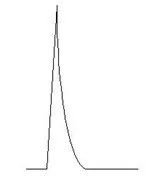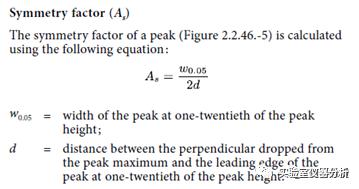In chromatography experiments, we often encounter three terms: trailing factor, symmetry factor, and asymmetry factor, which are not well understood by many chromatographers and are sometimes confused. This article briefly describes the relationship and differences between the trailing factor, symmetry factor, and asymmetry factor in chromatography, and we hope it will be helpful.
A Gaussian curve is a standard curve in a normal distribution. The peaks in chromatography experiments should theoretically conform to their distribution. Therefore, the theoretical tower number is also an important characterization of the suitability of the chromatographic system. However, in practice, most of the peaks in chromatography experiments deviate from the Gaussian curve distribution due to the presence of a dead volume of the instrument and the adsorption effect of instrument components and stationary solution on the sample, resulting in peak asymmetry. The peaks in chromatographic experiments exist in three forms: forward extension, symmetry, and trailing, so this asymmetry is more indicative of the chromatographic peak shape state.

National pharmacopeias generally measure the state of peaks in chromatographic experiments by asymmetry, tailing, and symmetry factors. For the drug analysis chromatography experiment, if the solvent factor and substance adsorption or bonding phase tailing effect and other factors are excluded, purely from the column filling effect, if the front of the column is filled tightly. The back is filled loosely. Even if the effective tower plate number is qualified, the peak shows at the back trail. If the front of the hplc column is filled loosely and the back is tight, then the peak shows the front trailing. Usually, there are clear regulations that the dragging factor should be in a certain range.
Gaussian curve
Dragging factor
The dragging factor is a parameter used to evaluate the symmetry of the peak shape. The U.S. Pharmacopoeia, the European Pharmacopoeia, and the Chinese Pharmacopoeia all have provisions for the trailing factor.
The USP is a curve perpendicular to the baseline from the apex of the peak. A line parallel to the baseline at 5% of the peak height, the intersection of the two sides of the peak, and the intersection of the vertical line will divide the line into two segments, A indicates the length of the left segment, and B indicates the length of the right segment, as shown in the figure [Nan Pharmaceutical Classroom].
When A = B, T = 1, the peak is considered symmetrical; when A < B, T < 1, the peak tends to front extension; when A > B, T > 1, the peak is considered to tend to trail. The Chinese Pharmacopoeia refers to a curve from the apex of the peak perpendicular to the baseline, and then at 5% of the peak height to make a straight line parallel to the baseline, and the intersection of the two sides of the peak and the intersection of the vertical line will be divided into two line segments, respectively, called the first half of the peak and the second half of the peak, d1 indicates the length of the first half of the peak, W0.05 his 5% of the peak width at the peak height, as shown in the figure. C.P. dragging factor is expressed in T, and the formula is T = The CP dragging factor is calculated as T = W0.05h/2d1. When the length of the first half-peak = the length of the second half-peak, T = 1, the peak is considered symmetrical; when the length of the first half-peak is less than the length of the second half-peak, T < 1, the peak is considered to tend to forward extension; when the length of the first half-peak > the length of the second half-peak, T > 1, the peak is considered to tend to drag. The USP and C.P. have different characterizations of the tailing factor. The calculation is the same as the formula, and there is no difference between the two.
Asymmetry factor
The asymmetry factor is a parameter used to evaluate the asymmetry of the peak shape, which is close to the concept of the dragging factor. In the U.S. Pharmacopoeia, a curve is made from the apex of the peak perpendicular to the baseline. Then a straight line parallel to the baseline is made at 10% of the peak height. The intersection of the peak’s two sides and the vertical line’s intersection divides the line into two segments: A indicates the length of the left segment, and B indicates the length of the right segment. As expressed, the asymmetry factor and the formula are As=B/A.
Chromatographic peak asymmetry factor calculation chart
When A = B, As = 1, the peak is considered symmetrical; when A > B, As < 1, the peak tends to forward extension; when A < B, As > 1, the peak is considered to tend to trail. The Chinese Pharmacopoeia does not mention the concept of asymmetry factor. It can be similar to the USP regulation of 10% peak height at the value of the calculation or that the tailing factor is the asymmetry factor.
Symmetry factor
The symmetry factor is a special parameter, and there are inconsistencies between various chromatographic instruments and national pharmacopeias. One statement in the U.S. Pharmacopoeia is that the symmetry factor is the reciprocal of the asymmetry factor (which is generally rarely used). While the Japanese Pharmacopoeia and the European Pharmacopoeia specify the symmetry factor, and the formula is consistent with the USP trailing factor. The following chart shows the European Pharmacopoeia’s regulation of the symmetry factor.

The symmetry factor in Agilent’s ChemStation workstation is calculated as shown below, and the symmetry factor and dragging factor in Waters’ Empower workstation are the same. The equation for the asymmetry factor is the same as that for the dragging factor.
Agilent Chromatography Workstation Symmetry Factor Calculation Method The symmetry factor varies from standard to standard and from regulation to regulation, unlike the trailing factor and asymmetry factor calculation methods which are relatively fixed.
Discussion of the range of the trailing factor, symmetry factor, and asymmetry factor regulations
We often say that the Chinese Pharmacopoeia requires the trailing factor to be in the range of 0.95~1.05. Still, drug analysis chromatographers often overlook one point – a definite word limiting the trailing factor’s CP requirement. The Chinese Pharmacopoeia stipulates that the trailing factor should be between 0.95 and 1.05 for the quantification of the peak height method and below 0.95 is the pre-delayed peak. 0.95 is the front delayed peak, and above 1.05 is the trailing peak. It is generally believed that peaks with a trailing factor less than 2.0 can be accurately quantified by peak area in drug analysis chromatography experiments. However, it is necessary to specify the value of the trailing factor with the limit of the compound’s characteristics, theoretical tower plate number, separation, and other factors.
The European Pharmacopoeia and the British Pharmacopoeia provide for the determination of the substance or content unless otherwise specified. The peak symmetry factor of the control solution for quantitative use in the chromatogram should be 0.8~1.5.
The U.S. Pharmacopoeia requires a trailing factor of not more than 2.0 for certain compounds.
The Japanese Pharmacopoeia does not specify the range of the trailing factor.
From the constraints of the range of trailing factors in the pharmacopeias of various countries, there is no gold standard for trailing factors, and specific analysis is needed in the current chromatographic experiments.
Conclusion
Regardless of the trailing, symmetry, or asymmetry factor, our goal is to judge the symmetry or asymmetry of chromatographic peaks by them. No matter which parameter is used, only the same parameter is used to compare the peak shapes of different chromatographic peaks.
Using the same parameter to compare different peak shapes is only practical. Theoretically, the trailing factor is generally used in drug analysis chromatography experiments to determine the peak shape of chromatographic peaks. The trailing factor, asymmetry factor, or symmetry factor, consistent with the trailing factor calculation, is automatically calculated by each chromatographic workstation. Therefore, if the criteria for determining the peak shape of chromatographic peaks in each chromatographic workstation are mastered, the trailing factor, asymmetry factor, and symmetry factor can be fundamentally distinguished so that these parameters can determine the peak shape of chromatographic peaks in a compliant and accurate manner.
Post time: Mar-18-2023






